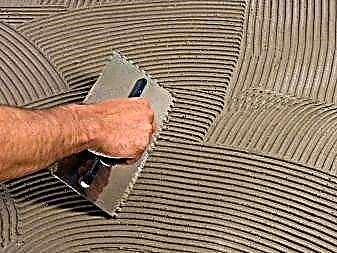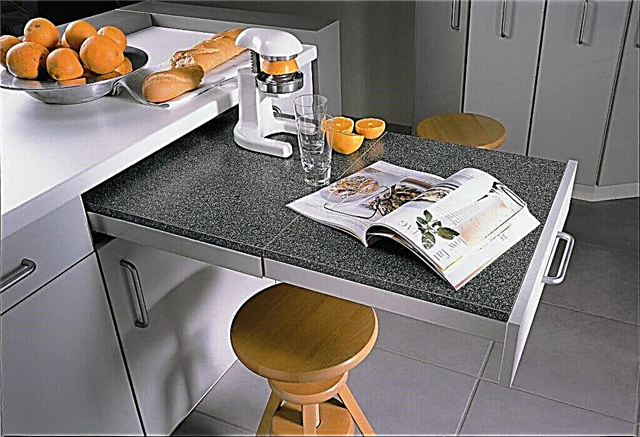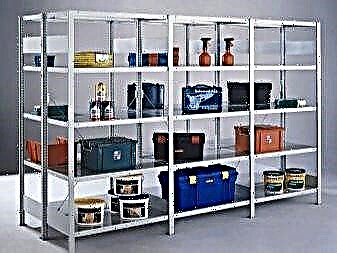It is very important that the curtains harmoniously frame the window, and the folds beautifully and elegantly complement the decor of the interior. To create such an image, a curtain tape is often used. This is a special hardware that is used in the formation of folds on curtains and curtains. They can be of various widths and shapes, translucent or white.
How to use curtain tapes is a natural question that arises immediately after the housewives find out what this device is.
In the center of the tape for curtains, ready-made loops are sewn, which involve mounting on special hooks. Hinges for hooks can be sewn in two, three rows. Several threads run parallel to each other across the width of the accessories, bottom and top: they are designed to create drapery.
At first glance, it is not clear how to use the translucent tape and ribbons to get the original folds on the curtains, how to fix it and what to do next.
Main purposes and advantages of a band for curtains:
- It makes it possible to elegantly and simply create a drapery of fabric of any texture.
- There is no need to sew additional loops and hooks.
- It does not shrink, which allows you to wash the product in any mode.
- Reduces sewing time.
- Quickly and easily pulled together with threads on the sides.
- It is possible to adjust and fix the width of the curtains, curtains.
It’s worth a little understanding of the topic, and beautifully draping a window is not difficult.
Curtain tape is called decorative soft accessories used to create folds of different widths and configurations on fabric.
Ribbon for curtains, varieties, description
Decorative braid is sewn from the front or the wrong side of the product. It not only performs the role of assembling folds, but also decorates the product. The original decorative tape for curtains can be sewn: on the lower edge, around the perimeter, on the sides. It can be additionally decorated with stones, rhinestones, lurex, beads.
Its use for window decoration is very common lately among designers, needlewomen and craftsmen for sewing curtains.
Types of decorative braid:
- For puffs. This view creates a decorative drapery of a special shape. This technique looks great on plain materials, creating a corrugated effect.
- Ruffles. They are sewn on the front side of the product. A country-style curtain is the most common model using decorative fittings in the form of ruffles.
- With ornament. These are products with various patterns, ethnic motifs. You can find decorative braid in Greek, Moroccan, African, English, Arabic, Japanese styles. With the help of such decorative details, accents are emphasized and a special ethnic element in the interior is emphasized.
- With fringe. It is used in styles with magnificent decoration: art deco, classic, empire, Victorian, oriental style.
- Openwork with lurex. The original finish for the curtains, which will make the product elegant and complete.
This inconspicuous detail can turn even the most boring curtains into chic curtains.
Ribbon with loops
Tapes for curtains with loops are widely used, they are inexpensive and without special difficulties are sewn to the seamy surface of curtains. On the upper and middle lines of the product are rows of loops for hooks. There may be several.
The most convenient thing in it is that it is not made of stretching fabric, but of dense material.
- With two rows of loops. For normal hanging curtains on hooks.
- With four rows of loops. For adjusting the length of the curtains without shortening the edges.
Note! If the curtains sag, then the number of hooks for the curtains is not enough, and they are not designed correctly. The second reason: too thin and narrow braid.
It is easy to sew on the machine to the fabric, and folds can be made of any density.
The loop with loops can be of two types:
- Transparent. It is made of kapron, designed for light translucent fabrics: organza, veil, mesh. Such accessories will be invisible on a thin and light fabric. Sewing a transparent tape is more time consuming and requires some experience and skill.
- Not a transparent tape. It is made of cotton for dense curtain fabrics. Before work, it is necessary to steam the tape to avoid unwanted shrinkage already on the finished product.
You can adjust their size and quantity with several laces that run through the entire length of the tape.
Adhesive tape for curtains
The use of adhesive accessories for curtains is justified only if the material is light.
Curtain tape simplifies the process of sewing curtains.
Fixation procedure for adhesive tape.
- Warm the strip with an iron, the heat will melt the glue on the tape to a liquid state.
- Gently fix the tape on the curtain until the glue has set: it connects securely to the curtain.
It does not require sewing loops to fix the fabric to the hooks - these loops are already provided on the tape.
Curtain tapes
They are divided into two types according to the formation of assembly types.
- Horizontal assembly. Used for sewing traditional curtains and lambrequins.
- Vertical assembly. Used for sewing Roman, French and Austrian curtains with lifting mechanisms.
Curtain tape allows you to beautifully drape fabric of any density and texture.
Eaves tape for curtains: description, functions, photo
- Grommet. It is created from kapron material, on the surface of which a layer of glue is applied. With it, you can install plastic or metal rings on the curtain. Its use is not necessary, but desirable: the curtains on the grommet curtain tape do not deform after washing and will last much longer.
- For pipe cornices. Depending on the diameter of the pipe, the width of the cornice tape is selected. Sewn threads are sewn from the wrong side of the tape, which are strung at the same distance onto the pipe cornice.
The tape makes it possible to adjust the width and length of the curtains, without resorting to radical methods of cutting and hemming of fabric.
- For string cornice. This is a design with a thin wire stretched over which the curtain is stretched using a special tape.
- Tape with hooks and Velcro. A great option for heavy curtains. The sticky part is attached on one side to the fabric. Hooks perform the function of a strong connection of the cornice and fabric.
- Velcro tape. It is preferable to use for curtains with a vertical type of assembly. This type can withstand significant weight, even the use of a lower weighting agent.
- With a magnet. Small magnets are fixed on the strip of tape of small width, at the same distance from each other.
Even a transparent tape is made of durable material that does not crumble and does not lose shape.
Assembly of curtains on a tape
Consider the design of the assembly of tape curtains.
- Ordinary folds. It is relevant for the material of any texture, suitable for almost all types of interior design. To create a beautiful drapery you need 1.5 times more fabric than the length of the cornice.
The fittings do not fade and do not deteriorate over time.
- In the form of a cylinder. Such folds are relevant for heavy types of curtains. When forming cylindrical folds, it is necessary to observe that in the places of bending the curtains look symmetrical.
Quality assembly gives crisp and neat folds.
- Beam folds. This type of assembly creates a unique elegant look. It is used to design long curtains.
Braids for this type of assembly need 2.5 times more than the length of the cornice.
- French assembly. To create a triple fold, the hooks must be locked from the back of each of the folds.
The curtain is easily pulled together with cords.
- Byte drapery. A great option for plain fabrics. Using the braid, you can form even folds. The length for this drapery should be at least 2.5 times the length of the cornice.
Byte drapery is often used in the processing of the edges of tablecloths, wraps.
- Puffs. In appearance, this drapery resembles a honeycomb. To create it, you need to take a wide ribbon with several rows of loops. Puffs look great on heavy plain and colored fabrics with a pattern.
For assembly in the form of a buffer, the material for drapery must be taken twice as much as a curtain rod.
- Waffles. Modern option: suitable for short kitchen curtains, and for long curtains in the living room.
Mostly it is better to use this option for plain fabrics.
Various types of drapery make it possible to complement the interior with a special chic. In curtain models that use curtain tape, the folds of the photo before and after show the obvious advantage of using this hardware in the design of the window.
Nylon tape is used to preserve the aesthetic appearance of curtains.
We have a curtain that needs to be folded, and two ways to do this without a sewing machine
The first method is suitable for heavy, opaque material, and today designers with Velcro Velcro not only offer draw up mansard curtains and pick up the bottom of the heavy curtains, but also drastically change the height of the curtains.
Many people know that in harsh climates it is good when the curtain is higher than the radiator level, this helps to save energy and seriously increases the air temperature in the room. And almost everyone is aware that when it is hot and sunny, a tight curtain helps keep the room cool.
Just Velcro helps to regulate the height of the curtains from floor to window sill, and you should not think that this is a crazy idea. The Velcro is not visible from the outside, and with this tape you can collect curtains into a very beautiful window frame.
However, there are several problems with this tape:
- Self-adhesive substrates are constantly experiencing "tensile stress", and after a dozen washes, the tape may fail.
- The open part of the tape will quickly become dusty, which will significantly reduce the adhesive qualities of the tape.
- Cleaning this clasp is a rather time-consuming operation.
They solve this problem quite simply:
- Stick the excess tape (it is sold on a roll and always with a margin) onto an empty area. When it’s needed, “overhang” (sorry for this word) the excess on the freed portion of the tape,
- To clean the contaminated part of the tape, use regular office tape with a small width. It is enough to glue it, squeeze it lightly with your finger, heat a little (for example, with a hairdryer) and peel off. After such an operation, Velcro will work like a new one,
- For heavy fabrics, a cardinal solution is needed - stitching. Here you need to understand that the total thickness of the Velcro should be greater than the thickness of the curtains. Otherwise, the adhesive layer simply can not withstand the loads.
In other words, Velcro is a great way to decorate a window exactly the way you want, but it’s worth considering that such Velcro is designed for a small tear-off force available to the child. And it is children that are precisely the factor that can ruin any interior. But there is a second method, more time-consuming, but more reliable.
Spider web tape, iron, curtain and 5 minutes per linear meter
This is approximately the advertisement of the second way to shorten the curtain without a sewing machine using a self-adhesive tape "spider line".
Today, many manufacturers invest in a set of curtains not only worthless “hooks” for “string cornices”, which have not been produced for 6 years, but also rolls of this “web” itself.
Let’s see how to use the “spider line” correctly if we don’t want to cut the curtain, brush off the dust from the sewing machine, and generally we have a day off, and only three hours for the husband to help make out the window at last. So:
- Rule one: in addition to the cobweb, curtains, iron and five minutes, you need an assistant, two pins, an ironing board (ideally a thin blanket on a flat board), several sheets of A4 paper, a damp sponge, good lighting and patience,
- Rule two: you need to remember that the iron is heated unevenly on the sole, the fabric cannot be laid out without a hint, it is almost impossible to smooth the bend evenly on the fabric without a pattern.
- Rule three: the foldable curtain should hang on the ledge for several days to take shape. To make it smooth, spread it out and spray the bottom with clean water. The wet bottom of the curtain will become a “load”, which will smooth the curtain. As it dries, determine the floor level with regular clothes pegs. In two days, you will know the exact length of the curtain. It remains to prepare everything so that the curtains that you find in the store become the curtains of your dreams.
Take a fabric that is suitable for the curtains by density, check at what temperature the spider line will stick. Enough piece of 20x20 cm., Making sure that the "cobweb" is stuck, sharply pull over the edges. If at least a part comes off, use the "cobweb" in two layers.
Prepare a dry towel, sheets of paper, a damp cloth, and pour water from the steam iron.
If you have a regular ironing board, put something flat on it, (board), cover with a plaid and do not throw out the hooks that are now put in the curtain sets.
Now let's shorten our curtain.
Practical recommendations for using the spider line adhesive tape
Bend the curtains hanging on the cornice from below so as to provide the desired distance from floor level. Pins should be fastened every 30-40 linear centimeters to ensure an even line without wrinkles. Iron the fold line, this will simplify the work.
Make sure the fabric is dry and sizing can begin:
- Flatten the fabric and place the adhesive tape under the glued edges so that it is completely covered by the fabric,
- For tulle, use a sheet of A4 paper, which lay on the seam, and press on top with an iron for 25-40 seconds. Lift the iron, move the sheet of paper and repeat until you glue the entire connection,
- Pins that secured the bonding line, remove as you move, so as not to stray, while adjusting the "spider line" so that it does not go beyond the edge of the fabric. If it comes out, it will stick to the paper. Carefully tear off the paper in the direction "from the floor", correct the "spider line" and take another sheet of paper,
- Warm the edges of the seams for a little longer, there you can even bend the "cobweb" in half.
Wait 10 minutes, and your curtain will be completely ready.
This work is easiest to do together, but you can do it alone. And the bonding quality will be such that the bottom of the curtain after many washings does not peel off, while maintaining the correct dimensions.
Curtain tape
 Curtain braid can be divided by type of drapery:
Curtain braid can be divided by type of drapery:
- Column. It forms the simplest folds, such a braid is easy to sew on your own,
- Tape that can be tightened crease in the form of intricate glasses or butterflies.
- Transparent. Light fabrics are draped: tulle or organza. Such a string is a fishing line that does not have color, it remains invisible.
- Opaque. Fabric curtains are implied.
Depending on the width, the tape for curtains is divided into types:
1. Narrow. Used if there is a closed cornice or it is hidden in a niche. It is possible that the niche covers the top of the curtains or there is a decorative strip covering the hooks.
2. Wide. In this case, the cornice should be open. In addition, if the number of fasteners is small and you want to prevent sagging, then this will successfully complete a wide tape.
So different folds
The drapery created thanks to the curtain tape will look different. The types of folds can be as follows:
- One sided. Fold waves form in one direction.
- Oncoming. The fabric is divided into paired waves, and their scallops are directed to each other.
- Bow folds. There is the same formation of paired waves, only now their scallops are scattered to the sides. Outwardly, the figure resembles a bow.
- Puff. Tightened fabrics form a rhombus, which form four cords.
- French or triple. Waves reaching a depth of up to 14 cm are formed in the form of a fan.
- Glasses or bells. Body waves falling down.
- Tapestry. Two rows of drapery that overlap each other.
- Waffle. Drapery looks very elegant when the waves lie evenly over the entire surface of the curtain.
- Pencil assembly using loop-shaped folds. To do this, the expanded curtain is pulled together by a cord, forming waves, taking into account the gaps between the hooks.
- The folds are Flemish. This requires the presence of two cords on the braid. By uneven contraction, a V-shaped configuration is achieved.
Types of drapery ribbons
There are many of them, and each species makes it possible to create certain folds at the discretion of the hostess. For example, there may be such curtain tapes:
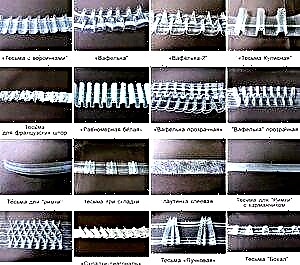 1. For the proportional collection of folds on the surface. It has pockets evenly distributed along the length. Using special hooks, tucks are created on the surface of the canvas.
1. For the proportional collection of folds on the surface. It has pockets evenly distributed along the length. Using special hooks, tucks are created on the surface of the canvas.
2. Braid using cords for assembly. It is sewn to the very top of the fabric, later the cords are pulled together to the required size and fixed.
3. Ribbons forming bows. The condition for education is the width of the curtain, which should be three times wider than the cornice.
4. Ribbons forming bows. The size of the curtain is chosen wider than the length of the cornice 2.5 times.
5. A narrow tape that is attached to the top of the curtains and forms small folds due to two elastic bands built into it. It is estimated that the curtain is 2 times wider than the length of the cornice, but its size should not exceed 158 cm.
6. Tape with pinches. In this case, the ratio of the size of the curtain to the cornice is calculated as three to one.
7. The tape is wide. It is used when it is required to obtain pencil folds - narrow, but rather long.
8. The tapes used in Roman curtains are equipped with rings, as well as a cord on which the loops are located. Attached to the blinds.
9. Tape with rings attached to it. Rings are made of plastic, sewn at a certain interval. The tape itself is attached to the blinds vertically from the wrong side. A cord will stretch through all the rings.
Types of braid
And here there are varieties. Band for curtains is:
- Narrow up to 4 cm and wide up to 15 cm.
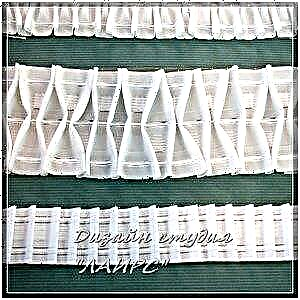 Differ in the number of broach pockets for hooks.
Differ in the number of broach pockets for hooks.- Different in assembly factor: from 1.5 to 3. The fold frequency depends on the value of the coefficient.
- Sewing - fixed to the curtain with a sewing machine.
- Some types of braid are glued with a hot iron to the curtain.
- It is fixed on the cornice with the use of Velcro, as well as loops.
The material from which the curtain tape is made is polyester. It adjoins to a curtain cloth literally at every point, prevents sagging and deformation of material. Loops are sewn to the tape along its entire length, for which the hooks of the cornice cling. In addition, the curtain tape may contain:
- Eyelets rings,
- Pockets in case of fastening on hooks,
- Gaskets,
- Cords in an amount of two to four pieces.
If simple assembly is required on the curtain, hooks are used that are threaded into pockets or loops. If the material is heavy, the hooks are made of brass; for light material, plastic hooks are enough. There are varieties of special hooks that are used to form triple or bow folds.
If one row of loops forms simple folds, then 3-4 rows form folds of complex configuration.
When choosing a tape, you should consider its length, which depends on the size of the folds that you want to have on the curtain.
Sewing Tips
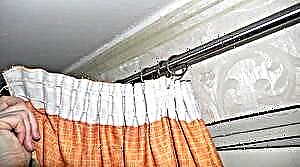 Before the braid is sewn to the curtain, some work should be done. This is preceded by a measurement of the cornice, curtains and braid. Moreover, 15 cm of the tape length should be added to the resulting curtain length as a margin. Given that the braid shrinks, it needs to be adjusted. For this purpose, it is wetted, dried and passed through it with a hot iron. All seams of the curtains must be processed.
Before the braid is sewn to the curtain, some work should be done. This is preceded by a measurement of the cornice, curtains and braid. Moreover, 15 cm of the tape length should be added to the resulting curtain length as a margin. Given that the braid shrinks, it needs to be adjusted. For this purpose, it is wetted, dried and passed through it with a hot iron. All seams of the curtains must be processed.
The braid is attached to the curtain in its upper part with an indent of 2-5 mm, moreover, from the wrong side, and its edges should be tucked 2 cm. Using the cord tightened to a certain size, the necessary configurations are obtained. Next, fix the cord, which will fix the desired state of the curtain. The optimal assembly coefficient is 2-2.5, and the opulence of the curtain curtain depends on this.
Thus, a correctly selected curtain tape can work wonders even with inexpensive material, creating intricate figured folds and providing a chic look to the living room.
What curtain tape to choose for curtains
When choosing a curtain tape, it is necessary to take into account the style of the interior, the place where the product will hang, and from which fabric it will be sewn.
It should be borne in mind that the process of sewing invisible tape requires some skills.
The main selection criteria.
- Mount. The tape should correspond to the provided fixation option on the cornice: using hooks, Velcro, eyelets. For the string cornice, any option is suitable, and for the pipe cornice - eyelets and hooks.
- Type of cornice. The cornice, hidden under a drywall niche, makes it possible to use almost any tape, since it will not be visible from under the bar.
- Fabric curtains. Dense fabrics of velvet and velor, jacquard, linen and taffeta require a wide ribbon of opaque material, since taking into account the assembly and texture of the fabric, the product will have a fairly large weight. For organza and satin, veil and silk, you can buy a medium or narrow curtain tape made of translucent material.
- The design of the room. For classic design, the use of ordinary and radial folds will be relevant. For the interior with chic elements, assemblies by the type of puffs are suitable.
- Build factor. It depends on two factors: the texture of the material and the type of assembly.
You can fix the curtain tape on the string cornice with the help of loops, Velcro, eyelets, hooks.
Choosing the right tape width.
- Narrow Suitable for light tulles and drapes without a special design, which require only hanging on the ledge.
- Medium. Has an additional row of loops for hooks. The width of such a tape is from 40 mm. This type of tape is perfect for lambrequins and curtains of moderate severity.
- Wide. It has a width of 60 mm. The best option for heavy curtains and curtains with a high build ratio.
The most important characteristic of a curtain tape is the type of folds it gives.
Varieties of curtain tapes are determined by their purpose
Each type is designed to pick up the canvas in a certain way.

Threads for tightening the tape must be pulled out from under the seam.
To buy a braid of the required dimension, you should determine the density index of curtain curtains. Each density corresponds to a coefficient that determines the required dimensions of the ribbon for the drawn curtains. For example, a ½ ratio means: to get 1 m of finished curtains, you need two meters of curtains, 1/3 - 3 meters and so on.
To the resulting length, you need to add 10 centimeters for bending the edges.
The selection of the curtain tape by the coefficient is based on the assembly of what forms it is planned to lay on the drapery:
- assembled in a simple way will not require a large consumption of material, the coefficient for it is 1.5,
- assemblies like ruffles, puffs or waffles need double-coefficient braid,
- folds by the type of “rays” and “bows” - a factor of 2.5,
- for folds-cylinders and triplets, a factor of 3 should be provided.

The finished curtain must be ironed and the tape tightened to the planned width.
In most cases, the curtain tape is made of polyester fabric. The advantages of the material are obvious: a tight fit to the curtain, a strong hold of the canvas along the entire width, the exclusion of sagging and deformation of the curtains.
What curtain tapes can consist of:
- from rings for grommets,
- from pockets for hooks,
- from seals for rigidity of a lambrequin,
- of two, three or four cords.
They produce a variant of braid glued to the curtain fabric due to Velcro, it is not equipped with cords. All tapes are attached in different ways and have different devices for these purposes. Produce the tape "wagon" with a different level arrangement of loops and pockets. They can be used on rail baguettes, as well as on rod frames. Curtain tapes made of translucent materials are intended for curtain curtains or made of organza.
Sewing sequence
Before working, the edges of the curtain should be trimmed by bending the sections and stitching them. The top edge is tucked on the wrong side with a width equal to the size of the tape and slightly larger. If the width of the hem of the sizes of the braid is exceeded, its edges are overlaid so that during the implementation of the work it does not sprinkle.
- Around the edge of the curtains cut off the edge. The edge is ironed 3 cm wide.
- The curtain tape with the ends bent in advance to the inside for 2-3 centimeters and the shoelaces released is sewn to the inside of the curtain, retreating 5-10 mm from the sides and bending to a double width of the 3-4 centimeter bend.
- Along the upper border, the tape is attached to the edge for the entire length of the curtain. Another line is done along the lower border of the braid.
- If there are three or four cords on the tape, it is attached along each.
- Twice bend the seam on the side. Prostrate to the edge.
- Pull the threads from under the seam to tighten the tape.
- The curtain is ironed and moved apart.
Tightening Technology
To pull off the curtain tape without any problems, the curtain tape must have at least three tie cords. They are tied to each end of the tape at the same time. It will be more convenient to pull off the curtain tape when there is an assistant. When performing the procedure alone, the second end is thrown onto the door handle.
Before starting work, the braid should be tightened. The connected cords of the free knot are clamped in one hand, and with the free hand, they braid the braid from the edges to the middle, moving the material along the cords.
The canvas is creased, and the cords are released, and they become longer. They are wound on a cardboard.
When the folds begin to impede the assembly process, they are pushed back to the fixed end of the product. Curtain braid with assemblies is measured with a tape measure, fitting to the desired width. The final stage is the distribution of the assembly and the fixation of the coil (do not cut!) Of the ropes from the edges of the braid.
Hooks are attached to the tape after 8-10 centimeters, after which they hang the curtain.

 Differ in the number of broach pockets for hooks.
Differ in the number of broach pockets for hooks.